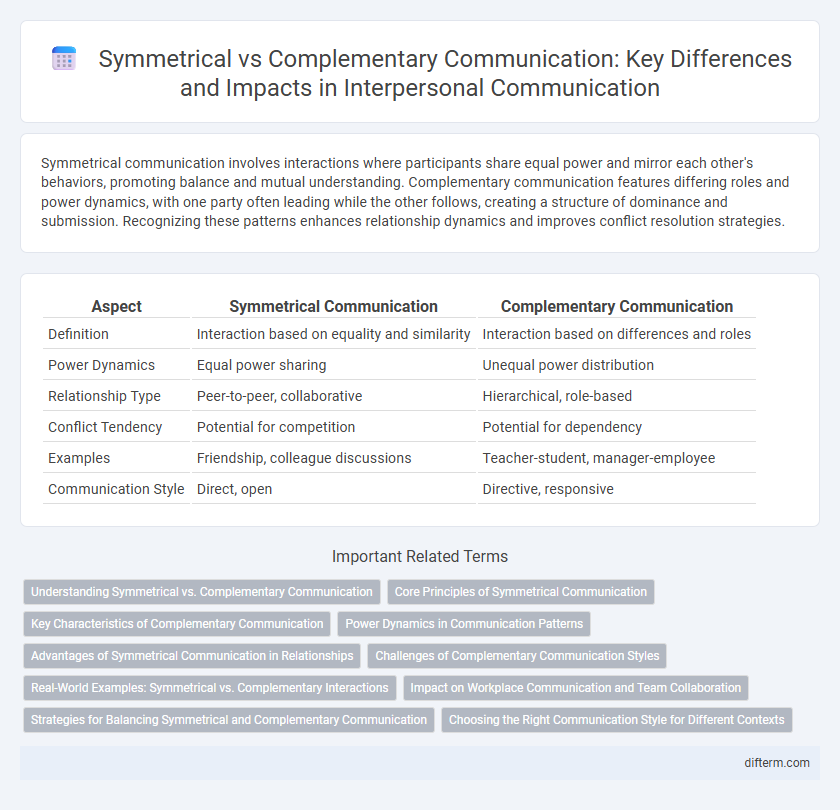Symmetrical communication involves interactions where participants share equal power and mirror each other's behaviors, promoting balance and mutual understanding. Complementary communication features differing roles and power dynamics, with one party often leading while the other follows, creating a structure of dominance and submission. Recognizing these patterns enhances relationship dynamics and improves conflict resolution strategies.
Table of Comparison
| Aspect | Symmetrical Communication | Complementary Communication |
|---|---|---|
| Definition | Interaction based on equality and similarity | Interaction based on differences and roles |
| Power Dynamics | Equal power sharing | Unequal power distribution |
| Relationship Type | Peer-to-peer, collaborative | Hierarchical, role-based |
| Conflict Tendency | Potential for competition | Potential for dependency |
| Examples | Friendship, colleague discussions | Teacher-student, manager-employee |
| Communication Style | Direct, open | Directive, responsive |
Understanding Symmetrical vs. Complementary Communication
Symmetrical communication involves interactions where participants mirror each other's behaviors or status, fostering equality and mutual understanding. Complementary communication occurs when individuals assume different, often hierarchical roles, creating a dynamic based on distinct but interdependent positions. Recognizing these communication styles enhances effective dialogue by adapting to relational contexts and power structures.
Core Principles of Symmetrical Communication
Symmetrical communication is grounded in the core principles of equality and mutual respect, emphasizing balanced interaction where both parties share similar power and influence. This communication style fosters cooperation, open dialogue, and trust, encouraging participants to express themselves freely and listen actively. By promoting reciprocity and minimizing dominance, symmetrical communication enhances relational dynamics and supports conflict resolution.
Key Characteristics of Complementary Communication
Complementary communication is characterized by interactions where participants adopt distinct, yet interdependent roles, such as leader and follower or speaker and listener, creating a balanced dynamic. This communication style emphasizes differences in power, status, or expertise, where one party typically directs the exchange while the other responds accordingly. Key features include clear role definitions, reliance on authoritative guidance, and predictable patterns that maintain social harmony and control.
Power Dynamics in Communication Patterns
Symmetrical communication patterns emphasize equality and mutual influence, where participants share similar power levels and negotiate meaning collaboratively. Complementary communication involves distinct power roles, with one party holding authority and the other adopting a submissive or supportive stance, reinforcing hierarchical dynamics. Power dynamics significantly shape these patterns, influencing conflict resolution, decision-making, and relationship satisfaction in interpersonal and organizational contexts.
Advantages of Symmetrical Communication in Relationships
Symmetrical communication fosters equality and mutual understanding by encouraging open dialogue and active listening between partners, which strengthens trust and emotional intimacy. It promotes conflict resolution through collaboration, reducing power imbalances that can lead to resentment. This balanced interaction enhances relationship satisfaction and long-term stability by valuing each individual's perspective equally.
Challenges of Complementary Communication Styles
Complementary communication styles often face challenges such as power imbalances, where one party assumes a dominant role and the other a submissive position, potentially leading to resentment or dependency. Misinterpretations arise when the non-dominant partner feels undervalued or ignored, disrupting effective dialogue. Resolving these issues requires awareness and adjustment to ensure mutual respect and understanding despite contrasting interaction patterns.
Real-World Examples: Symmetrical vs. Complementary Interactions
Symmetrical communication occurs when participants engage on equal terms, such as coworkers collaborating on a project or friends sharing opinions in a casual conversation. Complementary communication is characterized by unequal roles, evident in teacher-student dynamics where instruction flows predominantly from the educator to the learner. Understanding these interaction types enhances effective communication strategies in workplaces, educational settings, and personal relationships by adapting to the underlying power structures and relational goals.
Impact on Workplace Communication and Team Collaboration
Symmetrical communication fosters equality and open dialogue, enhancing trust and collaboration among team members by encouraging the exchange of ideas on an even footing. Complementary communication, characterized by unequal power dynamics, can streamline decision-making but may limit creativity and inhibit open feedback. Understanding these communication styles helps organizations optimize workplace interactions and improve overall team performance.
Strategies for Balancing Symmetrical and Complementary Communication
Effective communication balances symmetrical and complementary approaches by fostering mutual respect and adapting interaction styles based on situational needs and power dynamics. Employing active listening and empathetic feedback encourages symmetry, while recognizing role differences and maintaining clear boundaries supports complementary communication. Strategic flexibility enhances relational harmony and promotes productive exchanges in diverse social and professional contexts.
Choosing the Right Communication Style for Different Contexts
Symmetrical communication, characterized by equal power dynamics and mutual exchange, enhances collaboration in peer-to-peer or team settings. Complementary communication, involving distinct roles and hierarchical differences, is effective in structured environments like leadership or instructional contexts. Selecting the appropriate style based on situational power balance and communication goals optimizes clarity and relationship outcomes.
symmetrical vs complementary communication Infographic

 difterm.com
difterm.com